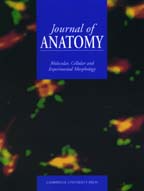No CrossRef data available.
Article contents
The acetabular point: a morphological and ontogenetic study
Published online by Cambridge University Press: 25 June 2001
Abstract
The acetabular point was analysed by studying human pelvic bones from 326 individuals ranging from newborns to age 97 y. The bones were categorised into 3 groups according to the degree of fusion for the 3 elements of the pelvis: nonfused (59), semifused (5) and fused (262). The acetabular point in immature pelvic bones is clearly represented by the point of the fusion lines for each bony element at the level of the acetabular fossa. In adult pelvic bones the acetabular fossa has an irregular clover-leaf shape, the superior lobe being smaller than the anterior and posterior lobes. Cross-sectional analysis of acetabular morphology suggested that the acetabular point in adult pelvic bones is always represented by the indentation between the superior and the anterior lobes of the acetabular fossa.
Keywords
- Type
- Short Report
- Information
- Copyright
- © Anatomical Society of Great Britain and Ireland 2001


